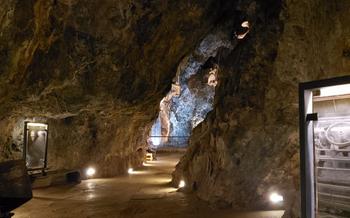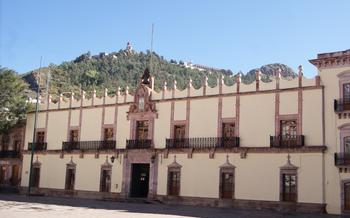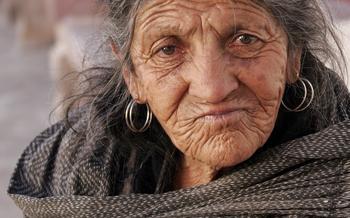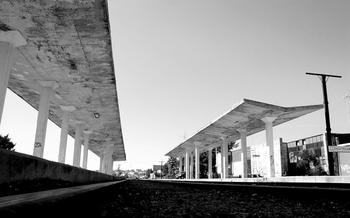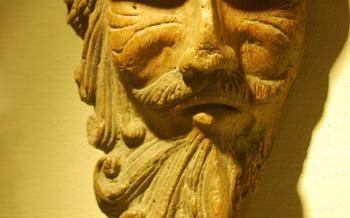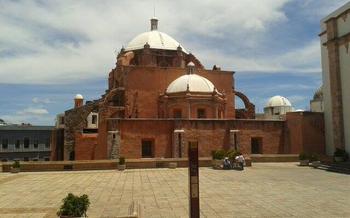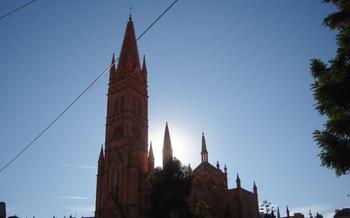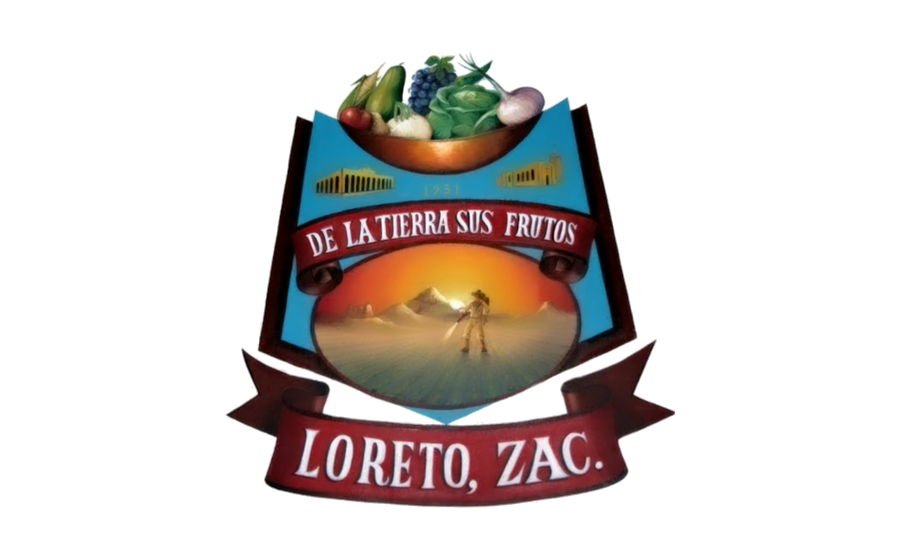
Templo de San Roque
- Architectural Marvel:
- Interior Beauty
- Religious Significance:
- Cultural Importance
- Guided Tours:
- Mass Schedule
- Photography and Videography
- Accessibility:
- Dress Code
- Souvenirs and Donations
- Language Assistance
- Nearby Attractions
- Local Cuisine
Architectural Marvel:
The Templo de San Roque stands as a testament to the grandeur of Baroque architecture, showcasing intricate details and a harmonious blend of indigenous and European influences. Its facade captivates with twin bell towers that pierce the sky, each crowned by a delicate cross. The arched doorways, framed by intricate carvings, invite visitors into a sacred space. The use of local cantera stone lends a warm, earthy tone to the temple, while the decorative elements, crafted by skilled indigenous artisans, reflect the rich cultural heritage of Zacatecas.
The temple's interior is equally breathtaking, adorned with elaborate artwork and religious imagery that transport visitors to a realm of spirituality and devotion. The main altar, a masterpiece of Baroque artistry, commands attention with its gilded carvings, intricate paintings, and a resplendent image of San Roque, the patron saint of the temple. Side chapels, each dedicated to a different saint, offer intimate spaces for prayer and reflection, their walls adorned with colorful murals depicting biblical scenes. The dome ceiling, a symphony of colors and intricate designs, adds to the temple's grandeur, drawing the eye upwards towards the heavens.
Interior Beauty
The interior of the Templo de San Roque is a testament to the artistry and devotion of its builders. The main altar is a Baroque masterpiece, adorned with intricate carvings, gold leaf, and a stunning altarpiece depicting the life of San Roque. The side chapels are equally impressive, each dedicated to a different saint and featuring unique artwork and iconography.
The dome ceiling is a breathtaking sight, painted with vibrant frescoes depicting scenes from the Bible and the life of San Roque. The walls are adorned with colorful tiles, religious paintings, and sculptures, creating a visually stunning and awe-inspiring space.
One of the most striking features of the interior is the large stained glass window above the main altar. The window depicts San Roque healing the sick and is a beautiful example of the artistry and craftsmanship of the time.
Religious Significance:
The Templo de San Roque holds a profound religious significance for Catholics in Zacatecas, serving as a place of worship and pilgrimage. The temple is dedicated to San Roque, a popular saint known for his healing powers and protection against epidemics. Devotees from all over the region flock to the temple to seek blessings, pray for healing, and pay homage to the saint. The annual feast of San Roque, celebrated on August 16, is a grand occasion marked by colorful processions, religious ceremonies, and festive gatherings. During this time, the temple becomes a hub of religious fervor and devotion, attracting thousands of pilgrims who come to pay their respects to the beloved saint.
Cultural Importance
The Templo de San Roque is deeply intertwined with the cultural fabric of Zacatecas, serving as a symbol of its identity and heritage. Its enduring presence has shaped the city's cultural landscape and left an indelible mark on local traditions and customs. The temple is associated with numerous legends, folklore, and popular beliefs that have been passed down through generations, adding to its mystique and significance.
One of the most captivating legends associated with the temple tells the tale of a mysterious benefactor who donated a large sum of money for its construction. According to the legend, the donor wished to remain anonymous and instructed the builders to use the money to create the most beautiful and majestic temple they could imagine. The result was the stunning edifice that stands today, a testament to the benefactor's generosity and the skill of the local artisans.
The Templo de San Roque is also closely linked to the annual Festival of San Roque, held every August in honor of the temple's patron saint. During this vibrant festival, the streets of Zacatecas come alive with music, dance, and colorful processions. Devotees from across the region gather to pay homage to San Roque, seeking his blessings and protection. The festival is a testament to the deep devotion and cultural significance of the temple, drawing thousands of visitors each year.
Guided Tours:
To fully appreciate the rich history, architecture, and religious significance of the Templo de San Roque, consider booking a guided tour. These tours offer a unique opportunity to explore the temple's hidden corners, learn about its fascinating stories, and gain insights from knowledgeable guides.
Guided tours are available in various languages, ensuring that visitors from all over the world can enjoy a comprehensive and enriching experience. Whether you're interested in the temple's architectural features, religious significance, or historical context, there's a tour tailored to suit your interests.
During the tour, you'll have the chance to see restricted areas not accessible to the general public, such as the sacristy, the choir loft, and the rooftop terrace. You'll also learn about the temple's construction, its role in the community, and the stories of the people who have shaped its history.
To book a guided tour, contact the Templo de San Roque directly or through a reputable tour operator. Reservations are recommended to secure your spot, especially during peak tourist season. Prices vary depending on the type of tour and the number of participants.
Whether you're a history buff, an architecture enthusiast, or simply seeking a deeper spiritual connection, a guided tour of the Templo de San Roque is an experience you won't want to miss.
Mass Schedule
The Templo de San Roque welcomes devotees and visitors alike to attend mass and experience the spiritual atmosphere of the church. Mass is held regularly throughout the week, offering opportunities for prayer, reflection, and communion with the faithful. On weekdays, mass is typically held once in the morning, allowing visitors to start their day with a sense of peace and devotion. On weekends, multiple masses are scheduled to accommodate the larger number of worshippers who seek spiritual guidance and community.
For those seeking a truly immersive experience, attending mass at the Templo de San Roque is highly recommended. The church's stunning interior, adorned with intricate artwork and religious imagery, creates a serene and uplifting environment for worship. The harmonious blend of music, prayers, and the congregation's devotion creates a palpable sense of spirituality that lingers long after the service has ended.
Visitors are encouraged to dress modestly and respectfully when attending mass, as is customary in places of worship. It is also important to adhere to the church's protocols, such as maintaining silence during the service and following any specific instructions provided by the clergy.
Attending mass at the Templo de San Roque is not only a religious experience but also a cultural one. It offers a glimpse into the deep faith and traditions of the local community, showcasing the enduring significance of religion in Mexican society. Whether seeking spiritual nourishment or simply witnessing the beauty of collective worship, visitors are sure to be moved by the experience.
Photography and Videography
The Templo de San Roque welcomes photography and videography for personal and non-commercial purposes. Visitors are encouraged to capture the beauty and grandeur of the temple's exterior and interior through their lenses. However, it is important to respect the sanctity of the space and avoid disruptions during religious services.
Photography and videography are generally permitted in the temple's public areas, including the nave, side chapels, and the main altar. However, certain areas, such as the sacristy and the choir loft, may be restricted for photography and videography due to their sensitive nature.
It is essential to be mindful of the privacy of other visitors and to avoid taking pictures or videos that may cause discomfort or distraction. Using flash photography is generally discouraged as it can damage the delicate artwork and artifacts within the temple.
Visitors who wish to take professional photographs or videos for commercial purposes, such as advertising or publication, must obtain prior permission from the temple authorities. This ensures that the temple's integrity and intellectual property rights are respected.
By following these guidelines, visitors can capture their memories of the Templo de San Roque while respecting the sacredness of this historic and religious site.
Accessibility:
The Templo de San Roque embraces inclusivity and accessibility, ensuring that visitors with disabilities can fully experience its grandeur. Ramps and wheelchair-accessible entrances make it easy for individuals with mobility challenges to enter and navigate the temple. Designated seating areas allow for comfortable participation in religious services or quiet contemplation of the temple's beauty. The commitment to accessibility reflects the temple's dedication to welcoming all visitors, regardless of their abilities, to share in its spiritual and cultural significance. Visitors with disabilities have expressed their gratitude for the thoughtful design and accommodations, enabling them to fully immerse themselves in the temple's atmosphere and connect with its sacredness.
Dress Code
When visiting the Templo de San Roque, it is essential to observe the appropriate dress code out of respect for the sacred nature of the space. Modesty and decency are highly valued in Mexican churches, and visitors should dress accordingly. Avoid wearing shorts, tank tops, or revealing clothing that may be deemed inappropriate in a religious setting. Opt for lightweight, loose-fitting clothing that covers your shoulders and knees. For women, a skirt or dress that falls below the knee is recommended. Men should wear long pants and a collared shirt or a guayabera, a traditional Mexican shirt. By dressing appropriately, you not only show respect for the temple and its community but also blend seamlessly with the local customs and traditions.
Souvenirs and Donations
The Templo de San Roque offers a variety of souvenirs and religious items for visitors to purchase, contributing to the temple's maintenance and preservation efforts. From intricately crafted rosaries and candles to miniature statues of San Roque, these souvenirs serve as tangible reminders of the temple's spiritual significance. Visitors can also make donations to support specific projects or initiatives aimed at preserving the temple's rich heritage. Whether through purchasing souvenirs or making a donation, visitors can play a role in ensuring the continued legacy of this sacred space.
Language Assistance
The Templo de San Roque recognizes the importance of accessibility for non-Spanish speaking visitors. To ensure a welcoming and inclusive environment, the temple offers multilingual guides and translation services to assist visitors with understanding the history, significance, and religious practices associated with the site. Guided tours can be arranged in various languages, allowing visitors to fully immerse themselves in the temple's rich cultural and spiritual heritage. Printed materials, such as brochures and guidebooks, are also available in multiple languages, providing visitors with comprehensive information about the temple's architecture, artwork, and religious significance. With these language assistance services, non-Spanish speaking visitors can navigate the temple and its surroundings with ease, enriching their experience and fostering a sense of cultural understanding and appreciation.
Nearby Attractions
After exploring the Templo de San Roque, visitors can venture into the heart of Zacatecas to discover a wealth of nearby attractions. Just a short walk away lies the Plaza de Armas, the city's main square, where visitors can admire the Zacatecas Cathedral, a stunning example of Baroque architecture. The Palacio de Gobierno, with its intricate murals depicting scenes from Zacatecas' history, is also worth a visit.
For those interested in art and culture, the Museo Pedro Coronel showcases a diverse collection of Mexican and international artwork, including pieces by renowned artists such as Diego Rivera and Rufino Tamayo. The Museo Rafael Coronel offers a glimpse into the life and work of the Zacatecan artist Rafael Coronel, known for his surrealist paintings and sculptures.
History buffs can delve deeper into Zacatecas' rich past at the Museo de la Toma de Zacatecas, which chronicles the city's pivotal battle during the Mexican Revolution. The Mina El Edén, a former silver mine, provides a fascinating insight into the region's mining heritage.
To experience Zacatecas' vibrant culture, visitors can stroll along the Callejón de las Monjas, a narrow alleyway lined with colorful murals and artesanía shops. The Mercado González Ortega offers a bustling atmosphere and a chance to sample local delicacies and handicrafts.
These nearby attractions, each with its unique charm and significance, complement a visit to the Templo de San Roque, creating a comprehensive and enriching experience for visitors exploring the historical and cultural treasures of Zacatecas.
Local Cuisine
After exploring the historical and cultural treasures of the Templo de San Roque, visitors can indulge in the delectable flavors of traditional Zacatecan cuisine. The city is renowned for its rich culinary heritage, boasting unique dishes and flavors that tantalize the taste buds.
Within easy walking distance from the temple, visitors can find a plethora of local restaurants and eateries that serve authentic Zacatecan cuisine. These establishments offer a warm and inviting ambiance, allowing visitors to immerse themselves in the local culture while savoring the regional delicacies.
One must-try dish is the "enchiladas zacatecanas," a delectable combination of corn tortillas filled with a flavorful mixture of cheese, potatoes, and ground beef, topped with a rich red sauce and garnished with crema, queso fresco, and onions. Another local specialty is the "pozole zacatecano," a hearty soup made with hominy, pork, and a variety of spices, served with shredded cabbage, radishes, and lime wedges.
For those seeking a truly unique culinary experience, the "tamal zacatecano" is a must-try. These savory tamales are made with a special masa dough filled with a variety of ingredients, such as pork, chicken, or vegetables, and wrapped in corn husks. They are then steamed until perfection, resulting in a tender and flavorful dish that is sure to delight the palate.
Whether it's the tantalizing flavors of the enchiladas, the hearty comfort of the pozole, or the unique taste of the tamales, Zacatecas offers a culinary journey that perfectly complements the cultural and historical treasures of the Templo de San Roque.
